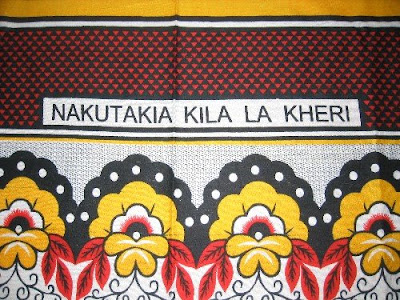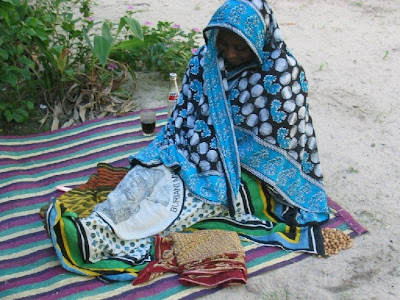– a living part of the East African culture
The Kanga (also spelled khanga) is an about 1 meter wide and 1,5 meter long piece of textile, which is used mainly in Kenya and Tanzania as garment, for carrying babies etc. In Uganda it is called Leso. The Kanga is of cotton and is printed using the silkscreen technique with a frame (pindo in Swahili) and a theme (mji) inside it. There is also often a slogan or proverb (ujumbe or jina) printed on the textile. The Kanga is easy to fold, tie and wind. It is often bought in pairs, and then cut to two pieces – one to wrap around you as a skirt and the other piece around your shoulders.The Kitenge (vitenge in plural) is another kind of textile, but of a thicker quality, and it has usually an edging only a long side or not at all. It is printed using rotary spinning machines. Even kitenge is sold in lengths sufficient to cover ones body. Specific patterns are designed for national holidays, jubilees etc. While similar textiles as the kitenge can be found all around Africa, the kanga is specific for East Africa and it has a fascinating history.
Women of Zanzibar created the Kanga
In the middle of the 19th century there was an abundance of imported goods in the bazaars in Zanzibar. Textiles were imported from India, the Far East and Europe. The Portuguese contributed with printed textiles to be used as shawls. They came in 0.50 meters wide rolls with square patterns. Normally you would cut off one square and sell it, but some women bought six squares instead, cut it in two pieces and sew them together to get new patterns.
 The story goes that the new patterns were called “Kanga” as they reminded of the plumage of the speckled guinea fowl. In Swahili, the word kanga means precisely that: guinea fowl. However, in the book “Kanga – the cloth that speaks” - available at Watatu - the writer Sharifa Zawawi, who is Professor Emeritus of Classical Languages, has a completely different theory on the origin of the word, which we will not reveal here.
The story goes that the new patterns were called “Kanga” as they reminded of the plumage of the speckled guinea fowl. In Swahili, the word kanga means precisely that: guinea fowl. However, in the book “Kanga – the cloth that speaks” - available at Watatu - the writer Sharifa Zawawi, who is Professor Emeritus of Classical Languages, has a completely different theory on the origin of the word, which we will not reveal here.”A wife is a fruit to take well care of”
In the beginning of the 20th century the trader Kaderdina Hajee Essak in Mombasa, often called Abdullah, got the idea of printing texts on the textiles, preferably proverbs from the rich Swahili cultural heritage. His textiles, which carried the trademark "K.H.E.-Mali ya Abdullah", quickly created a new fashion, which lasts up till today.
The texts are in Swahili, which is spoken in East Africa and Central Africa. It is the official language in Kenya and Tanzania (a union of Zanzibar and Tanganyika). The words on the kangas can often - if not just being printed for a jubilee or being political or religious slogans - have a double meaning. With a kanga you can indirectly say what you want to your neighbour, rival or others. The texts can be seen as document of historical and political events as well as prevailing values in the Swahili society and how they have changed during times.
The Mji and Jina (see above) are what characterizes the kanga and its popularity. The popularity of the Mji, that occupies the most important area of the kanga, save for its colours and the art, may be overshadowed by the context of the jina. The jina is usually printed in uppercase letters in colours that match the central motif and most likely on white background to improve its readability. Kangas without text are called kanga bubu – a dumb kanga.
In the beginning the pattern at the kangas was printed by hand using wooden stamps. Nowadays it is an industrial item, where the textile industry in Tanzania has to compete with cheaper copies (but of less good quality) of kangas from India and China, where even the text in Swahili is copied.
In sorrow and happiness
In Tanzania the kanga is used for all events in life. When a girl is going to be married, she is covered with kangas. She is also given kangas as gifts. Also when people go to celebrate the birth of a child, the women put a kanga around the waist, and when someone has passed, and people go to pay their respects, the women put a kanga around the waist.
There is a special design of a kanga called kisutu. It has a beautiful pattern with a lot of details and you can get it in red and black or blue. The red and black one is called kisutu cha arusi and in Zanzibar the bride is wrapped in it at the wedding day. At the permanent kanga exhibition at the National Museum of Zanzibar, they tell you that this specific ”wedding kanga” has a bloody story linked to it. It is said that a woman killed her husband with a knife, because he didn’t give her this kanga.
A kanga or kitenge for you
The kanga and the kitenge are wonderful products, you can really use them for everything. Our online shop has a wonderful selection of kanga and kitenge, other African textiles, baby carriers, African fashion, coffee, and much more! And, if you sew, kanga and kitenge work great in quilts or made into your own clothing, bags, curtains, or table cloths.



We are three old friends, Watatu (=three in Swahili), one from Sweden and two from Tanzania who are trying to promote the use of kanga and kitenge also outside East Africa. Do come visit our site!
Written by
Karin Zetterqvist
Watatu Textil
©Watatu
Sources:
”Textil i Afrika” by Erik Cardfelt, Karin Olsson
“Kanga – The Cloth That Speaks” by Sharifa Zawawi
Article “The Kanga” in Bang Magazine, July/August 2007













oooh oooohhhhh oooooooo i got my fabrics from Africa! they are Kangas and Kitenge!!!!!!!!!! they are so bright and colourful! now i know more about them... thanx to you :)
ReplyDeleteThanks so much for this! I will visit the site, i came back from africa with a pack half full of kitenges! I am now looking at some that i have converted into curtains, and another as the skirting for my bed. I love them! Its also suprisingly hard to find two of the same one (as i painfully discovered- after a good hour in Iringa searching)
ReplyDeleteA Dutch site that sells kanga and kitenge is leokesho.nl
ReplyDeleteIt seems to be cheaper than Watatu.
To the anonymous comment with the leokesho link, cheaper may not always be the criteria where we use our buying power. I took a look at the site and it is attractive and fun, but my question would be of how closely they work with the artisans and how profit is shared.
ReplyDeleteWhile buying kanga and kitenge in the country itself (Dar-es-Salaam, Tanzania) whe are investing in the Tanzanian economy. Perhaps not all Africans want to be seen as people you have to share your profit with, but just as full tradingpartners.
ReplyDelete